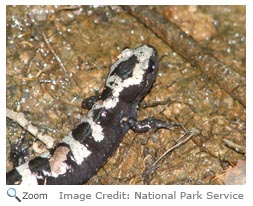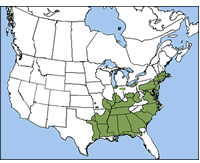Characteristics
 The marbled salamander is three to five inches long. It has a black body with white or silvery-gray markings. The female has gray markings and the male has white markings. It has 11-12 costal grooves (vertical grooves). The marbled salamander is three to five inches long. It has a black body with white or silvery-gray markings. The female has gray markings and the male has white markings. It has 11-12 costal grooves (vertical grooves).
Range
 The marbled salamander can be found from southern New Hampshire to northern Florida, and west to southern Illinois, southeast Oklahoma, and east Texas. It is also found around Lake Erie and Lake Michigan and in south west Missouri and along the northern border of Ohio and Indiana. It is a threatened species in Michigan. The marbled salamander can be found from southern New Hampshire to northern Florida, and west to southern Illinois, southeast Oklahoma, and east Texas. It is also found around Lake Erie and Lake Michigan and in south west Missouri and along the northern border of Ohio and Indiana. It is a threatened species in Michigan.
Habitat
The marbled salamander lives in forests and woodlands. It can be found in a variety of habitats, from moist sandy areas to dry hillsides. It spends most of its time in a burrow, in leaf litter or under bark and logs.
|
|
Diet
Adult marbled salamanders eat invertebrates including earthworms, slugs, snails, centipedes and a variety of insects. Larvae eat zooplankton. As they grow larger, they will eat tadpoles, insects and other salamander larvae.
Life Cycle
The marbled salamander breeds from September to October in the northern part of its range and from October to December in the southern part of its range. The marbled salamander mates and lays its eggs on land. The female lays 50-200 eggs, one at a time, in a depression under a log or in a clump of vegetation that will fill with water when it rains.
The female usually curls her body around the eggs to keep them moist and waits for rain to fill the depression. The larvae hatch a few days after being covered by water. If there is not enough autumn and winter rain, the larvae may not hatch until spring! The larvae will change into salamanders in about three to six months.
Behavior
Except for during breeding season, marbled salamanders are solitary creatures.
|